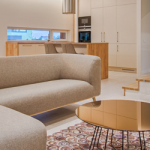Exploring the realm of interior design, the blog sheds light on the anticipated interior designer salary trends prevailing in India throughout 2024. This comprehensive analysis delves into the interior design annual salary packages and factors influencing salaries in this dynamic field.
In this blog, you will learn about the average salary of interior designer in India, alongside understanding the pivotal role and significance of interior design. Additionally, it provides insights into the path to becoming a successful interior designer, detailing the requisite steps and qualifications necessary to thrive in this creative domain.
Table of content
Who is an Interior Designer?
Starting Salary for Interior Designer in India
Average salary of Interior Designer in India
How to be an Interior Designer?
Key responsibilities of an interior designer
Importance of Interior Design
Top 5 Courses for Interior Design in 2024
Scope of Interior Design in India
Who is an Interior Designer?
An interior designer is a creative professional who conceptualizes and executes aesthetic and functional interior spaces, enhancing the visual appeal, functionality, and ambiance of residential or commercial environments. These professionals possess a blend of artistic flair, technical expertise, and a keen understanding of spatial design principles to transform spaces into aesthetically pleasing and purposeful areas.
Starting Salary for Interior Designer in India
An Interior Designer with a bachelor’s degree and 4-5 years of experience usually earns between INR 8 LPA to 13.8 LPA annually. A postgraduate Interior Designer in a similar position can command a higher range, averaging between INR 14 LPA to 20 LPA yearly. Independently working interior designer salary per month typically earn around INR 50,000 to 1 Lakh, while those in top firms can hit an annual average of INR 22 LPA to 24 LPA. For seasoned designers in leading companies, salaries can reach an impressive INR 44 LPA.
Average salary of Interior Designer in India
Interior design annual salary ranges from INR 8 LPA to 24 LPA, depending on factors like education, experience, and whether they work independently or with firms. Salary per month of an independent designers is around INR 50,000 to 1 Lakh, while those in top companies can reach an annual average of INR 22 LPA to 24 LPA.
How to be an Interior Designer?
Becoming an interior designer involves a blend of education, skills, experience, and creativity. Here are steps to pursue a career in interior design:
- Education: Obtain a degree in Interior Design or a related field from a recognized institution. The curriculum typically covers design principles, space planning, materials, construction, and software skills.
- Gain Practical Experience: Seek internships or entry-level positions at design firms, architecture companies, or interior design studios to gain hands-on experience in the field. This provides exposure to real-world projects and client interactions.
- Develop Skills: Hone skills in spatial planning, color theory, design software (such as AutoCAD, SketchUp, Adobe Photoshop), and knowledge of materials and furnishings. Creativity, attention to detail, and problem-solving abilities are essential.
- Build a Portfolio: Create a strong portfolio showcasing design projects, concepts, and any relevant work. Portfolios demonstrate skills, style, creativity, and the ability to interpret client needs.
- Networking: Engage with professionals in the industry by attending design events, joining design associations, and connecting with mentors. Networking can open doors to opportunities and collaborations.
- Certifications and Licensure: While not always mandatory, obtaining certifications like NCIDQ (National Council for Interior Design Qualification) or seeking licensure, if required in your region, can enhance credibility and career prospects.
- Stay Updated: Keep abreast of emerging trends, technologies, and innovations in interior design through workshops, seminars, and continuous learning. Continuous improvement is vital in this dynamic field.
- Start Your Career: Begin as a junior designer or assistant at a design firm to gain further experience. As skills and expertise grow, advance to more senior positions or consider establishing an independent practice.
By following these steps, aspiring interior designers can gradually build the necessary skills, knowledge, and experience to thrive in the field of interior design and carve out a successful career path.
Key responsibilities of an interior designer
Space Planning: Analyzing available space and developing layouts that optimize functionality, traffic flow, and usability while meeting the client’s requirements.
Design Development: Creating design concepts, selecting color schemes, materials, furniture, lighting, and accessories that align with the client’s preferences and project goals.
Project Management: Overseeing projects from conception to completion, coordinating with architects, contractors, and vendors, ensuring adherence to timelines, budgets, and quality standards.
Client Collaboration: Understanding clients’ needs, preferences, and budgets, effectively communicating design concepts, and incorporating feedback to create personalized spaces.
Knowledge of Codes and Regulations: Ensuring compliance with building codes, safety regulations, and accessibility standards while designing spaces.
Use of Technology: Proficiency in design software such as AutoCAD, SketchUp, or 3D modeling software to create visual representations and presentations of design concepts.
Trend Awareness: Keeping abreast of design trends, materials, and innovations to offer clients contemporary and innovative design solutions.
Interior designers collaborate with architects, contractors, and clients to craft interior environments that harmonize functionality, aesthetics, and the clients’ vision. Their expertise lies in transforming spaces into visually appealing, comfortable, and functional areas, showcasing creativity and technical prowess in equal measure.
Importance of Interior Design
Interior design holds significant importance across various aspects:
Enhances Quality of Life: Well-designed spaces contribute to improved quality of life by fostering comfort, functionality, and aesthetics. Thoughtfully designed interiors promote well-being, productivity, and overall happiness.
Optimizes Space Utilization: Interior design maximizes the potential of spaces, ensuring efficient use of available area while maintaining a harmonious balance between form and function.
Reflects Personal Style: Interior design allows individuals to express their personalities and preferences, creating spaces that resonate with their tastes, values, and lifestyle.
Improves Functionality: Strategic design solutions optimize functionality and flow within a space, addressing specific needs and enhancing usability.
Creates Ambiance and Atmosphere: Design elements such as lighting, colors, textures, and furnishings contribute to setting the ambiance, influencing moods and emotions within a space.
Adds Value to Properties: Well-designed interiors add value to properties, making them more appealing to potential buyers or tenants and often commanding higher market prices.
Supports Sustainability: Interior designers increasingly focus on sustainable design practices, integrating eco-friendly materials and energy-efficient solutions to minimize environmental impact.
Boosts Business and Retail: In commercial settings, interior design plays a crucial role in attracting customers, creating memorable experiences, and reinforcing brand identities.
Overall, interior design goes beyond mere aesthetics; it profoundly impacts functionality, comfort, emotions, and experiences within spaces, making it an integral aspect of our daily lives, both personally and professionally.
Top 5 Courses for Interior Design in 2024
Here are five top courses for Interior Design in 2024:
Bachelor of Interior Design (BID): This undergraduate program offers comprehensive learning in design principles, space planning, materials, and construction techniques. Universities like NID, CEPT, and various design institutes across India provide BID courses.
Master of Interior Design (MID): Pursuing a master’s degree in Interior Design allows for advanced studies, research, and specialization in areas like sustainable design, hospitality interiors, or retail design. Institutions such as SPA Delhi, NID, and Raffles Design International offer MID programs.
Diploma/Certificate in Interior Design: Short-term diploma or certificate courses provide focused training in interior design fundamentals, suitable for individuals seeking quick skill enhancement. Institutes like JD Institute of Fashion Technology and Vogue Institute of Fashion Technology offer such courses.
Online Interior Design Courses: Many accredited institutions and platforms offer online courses in interior design, providing flexibility for learning design concepts, software skills, and industry trends remotely. Platforms like Udemy, Coursera, and LinkedIn Learning offer diverse online interior design courses.
Specialized Workshops and Continuing Education: Participating in workshops, seminars, and continuing education programs hosted by industry professionals or design associations helps in staying updated with evolving trends, technologies, and design practices in the field of interior design. Institutions and organizations often organize such events and workshops throughout the year.
These courses cater to various levels of expertise and interests within the field of interior design, providing aspiring designers with a wide array of learning opportunities to suit their preferences and career aspirations.
Scope of Interior Design in India
The interior designing scope and salary in India continues to expand, offering abundant opportunities in various sectors:
- Real Estate and Construction: With the booming real estate industry, there’s a growing demand for interior designers to create appealing and functional spaces within residential and commercial properties.
- Hospitality Industry: Hotels, resorts, restaurants, and cafes are increasingly focusing on unique and immersive interior designs to attract customers, creating a niche for interior designers specialized in hospitality interiors.
- Retail and Commercial Spaces: Interior designers play a pivotal role in designing retail stores, offices, and commercial spaces, enhancing brand identity and customer experience.
- Residential Projects: The increasing emphasis on personalized home interiors has amplified the demand for interior designers in the residential sector, catering to individual preferences and lifestyle needs.
- Sustainable Design: There’s a growing trend towards eco-friendly and sustainable design practices, opening avenues for interior designers specializing in sustainable interiors.
- Event and Exhibition Spaces: Designers also contribute to event and exhibition spaces, creating engaging and immersive environments for trade shows, exhibitions, and events.
- Furniture and Product Design: Some interior designers diversify into furniture and product design, creating bespoke furniture pieces or accessories that complement interior spaces.
- Academia and Consultancy: Experienced designers often venture into teaching, mentoring, or consultancy roles, sharing expertise and guiding upcoming designers or advising clients on design projects.
Overall, the evolving lifestyles, urbanization, and the increasing appreciation for aesthetic and functional spaces in both personal and commercial spheres contribute to the ever-expanding scope of interior design in India. This field offers diverse opportunities for creative expression, innovation, and professional growth.
Conclusion
In conclusion, interior design in India presents a vast canvas of opportunities across diverse sectors, encompassing residential, commercial, hospitality, and sustainable design realms. The profession not only allows for creative expression but also demands a keen eye for functionality and aesthetics, catering to the evolving needs and preferences of clients. The scope for interior designers spans from shaping immersive retail spaces to crafting sustainable and personalized residential interiors. As for salaries, the field offers varying remuneration depending on factors like experience, expertise, and whether one works independently or with established firms, making it a dynamic and rewarding career choice for those passionate about shaping spaces and experiences.


















